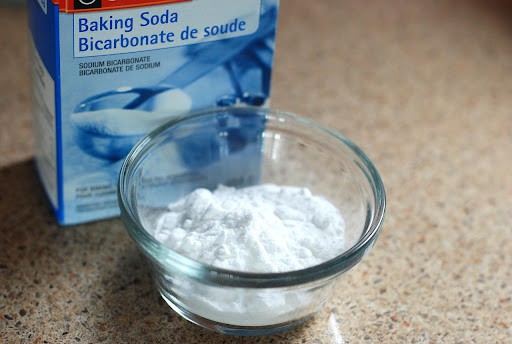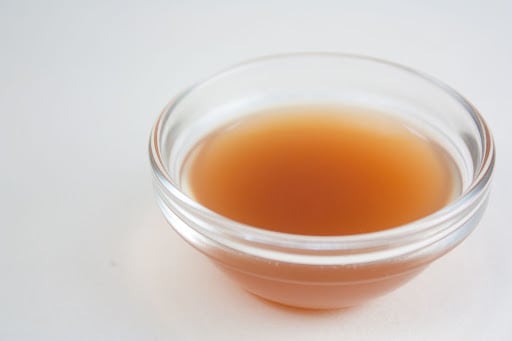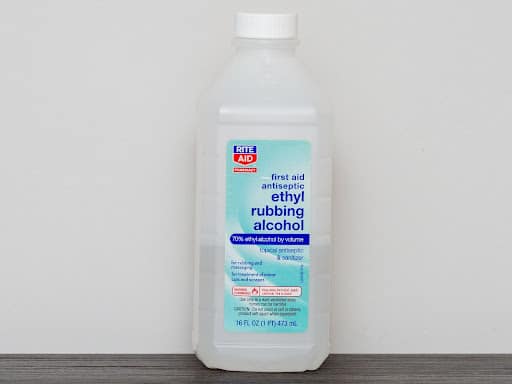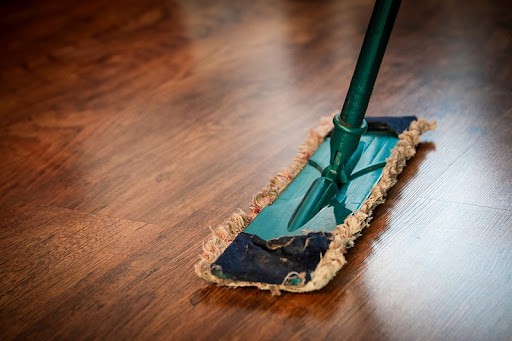Mix water and baking soda to form a thick paste. Apply it directly to the stained area and leave it for up to twenty minutes. Wipe with a clean cloth and repeat the process until the floor is completely clean.
Discoloration of vinyl flooring can happen for many reasons, including moisture, dust, exposure to sunlight, etc. The good thing is that most of them are curable and don’t require hard work.
This article discusses the best ways to clean stains caused by the discoloration of vinyl flooring. We also share essential aftercare tips so you can take better care of your floor in the future.
How to Clean Discolored Vinyl Flooring with Baking Soda

Baking soda is a mildly abrasive substance that removes stain-causing compounds from the vinyl flooring. It isn’t harmful to your skin or the environment.
There are two ways of using baking soda to clean vinyl flooring:
By Using Baking Soda and Water
Things You Will Need
- Baking Soda
- Water
- Sponge
- Cloth
Steps to Follow
- Mix water and baking soda in a bowl, making a thick paste.
- Rub the mixture in the affected area with the help of a sponge.
- Wait for about fifteen to twenty minutes and wipe with a cloth.
- Repeat the process as much as needed.
Points to Note
Don’t soak the floor after cleaning to avoid moisture damage. Also, allow it to dry by itself before walking or placing furniture on the surface.
2) By Using Baking Soda and Vacuum Cleaner
Things You Will Need
- Baking Soda
- Vacuum Cleaner
- Broom
- Cloth
Steps to Follow
- Use a broom to sweep the surface thoroughly.
- Sprinkle baking soda on the stain and let it sit for about fifteen minutes.
- Vacuum the area. You can also wipe it with a clean piece of cloth or lemon water solution if need be.
Points to Note
After cleaning the floor, make sure there’s no baking soda residue as it causes a yellow stain on vinyl. A microfiber cloth is more effective in wiping off baking soda from the floor.
How to Clean Discolored Vinyl Flooring with Apple Cider Vinegar

Apple cider vinegar is highly acidic, so it can easily dissolve dirt, grease, and other organic deposits on your vinyl. And when you combine it with dish soap, you won’t only be able to do a deep clean of the stain, but also wash any dirt or disease-carrying germs from the surface.
Things You Need
- Apple Cider Vinegar
- Dish soap
- Water
- Sponge
Steps to Follow
- Add a cup of apple cider vinegar with a gallon of water.
- Put up to two tablespoons of dish soap into the mixture and mix everything together.
- Use a brush or a mop with thin nylon bristles to rub the mixture over the affected area. You can also use a sponge.
- Scrub as needed, and allow the surface to dry afterward.
Points to Remember
Use a mild dishwashing soap. As you will be using chemicals for this one, you should be careful enough not to damage the surface.
Before applying the vinegar dishwasher to the entire flooring, see how it works in a small sample area. This is to make sure that the mixture isn’t potent enough to damage your vinyl.
How to Clean Discolored Vinyl Flooring with Rubbing Alcohol

Rubbing alcohol is a degreasing agent. Hence, it is the recommended option if you want to remove stains caused by greasy things such as makeup items, ink, oil, etc. In addition, it kills pathogens lurking on the floor.
Things You Will Need
- Rubber Gloves
- Protective Goggles
- Rubbing Alcohol
- Cloth
Steps to Follow
- Cover your skin with thick rubber gloves and wear goggles. Don’t skip this step as upon skin contact, rubbing alcohol can cause problems such as redness, dry and peeling skin, etc.
- Use a clean white cloth to soak the rubbing alcohol and apply it to the affected area.
- Scrub smoothly as required.
- As you remove all the stains, you will need to clean the floor with a microfibre cloth to avoid any alcohol to linger and cause further discoloration.
How to Clean Discolored Vinyl Flooring with Lemon
In addition to being an excellent cleansing agent, lemon also has great antibacterial and antifungal properties. It is mildly acidic and doesn’t damage the vinyl as it removes stuck particles that have been causing the discoloration.
Things You Will Need
- Whole Lemon
- Clean Cloth
- Paper Towel
The Process
- Take a whole lemon and cut it in the middle.
- Squeeze the lemon a little bit, and rub the cut part on the stain, dripping a little bit of juice on the floor.
- As the stain starts subsiding, use a clean wet cloth to wipe the floor off.
- Finally, use a paper towel or a towel to dry the floor completely.
Points to Remember
Instead of rubbing the affected area with a lemon, you can also use lemon juice.
Things You Should Never Clean Your Vinyl Flooring With
Using inappropriate substances to clean your floor can cause further stains. Here are some things that you should never apply to your vinyl flooring:
Abrasive Materials
While abrasive materials can seem great cleaning agents in the short term, they have the potential to permanently remove the color and shine of the outer material of the vinyl.
You should especially avoid abrasive materials while cleaning stains, as removing stains often requires the cleansing agent to sink deep into the flooring surface. And if abrasive materials get their way into the plank, they can damage its interior as well.
Examples of abrasive materials include:
- Bleach
- Abrasive detergents
- Hydrochloric Acid
- Oxalic Acid
Hot Water
Remember, vinyl is plastic, and most of its forms start melting after 100 degrees celsius. Now, your floor will definitely be able to handle that temperature once or twice, but regular use of hot water makes the surface weak and delicate.
Always opt for lukewarm water while mopping or using any above methods.
Steam Mop
The idea behind a steam mop is to expose stain-causing particles to a very high temperature so that their molecules start breaking and removing themselves from the surface. While it’s a great product, the heat created by the machine can easily break down vinyl planks.
Vacuum Cleaner
You should abstain from using a vacuum cleaner on your vinyl if possible. But if it’s absolutely necessary, use one with a soft brush. Also, don’t forget to remove the beater bar as it can cause unwanted scratches.
More Water than Needed
The problem with drenching your vinyl is that the water can flow down from the edges and damage the bottom part of the flooring. Furthermore, too much water can soften the glue or adhesive holding the planks together.
Caring for Vinyl Flooring to Avoid Staining in the Future

As with everything, prevention is the best cure for vinyl discoloration. Here are some practical tips to take care of your vinyl flooring:
Sweep Regularly
Most discolorations happen when dirt stays for a long time, slowly sticking to the surface. Hence, you should regularly sweep your vinyl flooring. Don’t forget to use a sweeper with soft bristles.
Use a Vinyl Floor Cleaner
Many commercial cleaners are available on the market, which are solutions of popular substances known to be able to clean vinyl deeply. Ask your flooring manufacturer if they recommend any particular brand for your floor.
Always Rinse After Cleaning
Remember, even the substances you use to clean your flooring can cause stains if you let them sit for a long time. Hence, after every cleaning session, make sure you have rinsed and dried your floor, so nothing is left behind.
Don’t Use Rubber Shoes or Rugs
There are two ways rubber can ruin your vinyl flooring. One is that it can put a lot of pressure on the floor, causing it to break.
A more important reason to avoid rubber is that most rubber products, such as shoes or rugs contain chemicals that can stick to and cause stains in the vinyl planks.
Take Steps to Protect Your Floor
These are the things you can do to take a good care of your vinyl floor:
- Purchase floor protectors for furniture. Don’t drag them around as they can cause dents.
- Wear soft slippers. Don’t walk on your floor with naked feet as it may cause marks, making you clean your floor more than needed.
- Cover the floor with rugs, especially where there’s the potential for spills to occur.
FAQs on How to Clean Discolored Vinyl Flooring
Can Water Damage My Vinyl Flooring?
Water won’t cause any issue during normal spillage as long as you wipe it off quickly. But a puddle can significantly damage your flooring since the water can travel to the bottom of the flooring and cause problems such as peeling off and material decay.
Can I Add a Water Vapor Barrier On My Vinyl Flooring?
It is highly recommended to add a water vapor barrier on vinyl flooring. It helps keep the moisture away, maintaining your floor’s shine and avoiding discoloration.